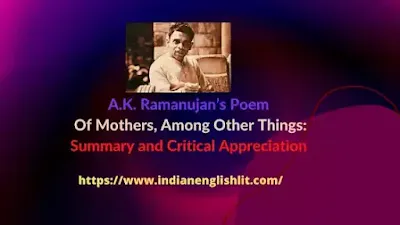Introduction to the Poem:
The poem entitled Of Mothers, Among Other Things is a poem based on the poet's recollections of his mother. It was published in Relations. In it, the poet communicates to the reader his own impressions about his mother during various stages of her life. During his stay in U.S.A., the poet remembers his mother and greatly longs for her company. In the poem, the poet conjures up various images of his mother from the dark vortices of memory. Although the poet's memory is dry with grief, yet he remembers how dedicate and vivacious she was in the prime of her life. The poet expresses his indescribable anguish in the very depth of his heart when he describes her helplessness to pick even a grain of rice from the floor of kitchen.
 |
| A.K. Ramanujan’s Poem Of Mothers, Among Other Things: Summary and Critical Appreciation |
Summary of the Poem:
The poet conjures up various images of his mother from the dark vortices of memory. Although his memory gives him grief, yet he remembers how delicate and vivacious his mother was. The poet recalls the blackbone tree which was bright, pleasant and beautiful in its youth, but now, has grown old like his mother. It had lost all the qualities of its youth. Now it had become rough. It was tended by his mother when it was young. The poet's mother looked very beautiful, gracious and delicate in her youth. She was as tender and delicate as the silk and the petal of flower, but now with the approach of old age, her beauty, graciousness and delicacy had disappeared. In her youth, she wore silk garments and looked a very charming woman. She wore ear - rings which were studded with diamonds. These diamonds shone and glittered, as if radiating light. In other words, from these diamonds came a large number of rays of light.
The poet recalls the days when his mother was young, beautiful and energetic and she did every work in a great haste without any difficulty. She had a very special affection for her children. She could not see them in any trouble. He recalls the incident when her babies were lying in their cradles in the courtyard under the tree and the mother had gone to do some domestic work in the house, suddenly it started raining and the mother came back running to pick up her babies from the cradles. She wanted to secure her babies from rain. She never hesitated to do hard work. He presents the beautiful picture of rain. The drops of rain seemed to be sewing the gaps of the leaves. The falling drops at a very short interval looked like broken threads. The gaps have been compared to the rags (pieces) of worn out clothes. The rain drops hanging from the edge of the leaves looked like the tassels which shone brightly when light reflected them. The rain symbolises difficulties, but the mother was accustomed to face them with courage, bravery and determination. She never allowed the difficulties to create any hindrance in her life.
This incident of rain in which the poet's mother ran towards her babies lying in their cradles, was related to a much later period of his mother's life. In rain the hands of the mother had become wet. Her hands resembled a wet eagle's two wrinkled and twisted feet or claws, with one claw having been severely damaged because it had got caught in a garden - trap. It happened so that a mouse had become the greatest cause of trouble for his mother, so she decided to catch this mouse by setting a trap. In order to get rid of this mouse, she set a trap in the garden. But - at the moment of setting trap, one of her hands got caught in the tight grip of the trap and it gave severely damage to her hand. The injury got by the trap could not be healed completely and it left its marks on her hand. But it did not affect her working efficiency. In spite of having this serious injury, her spirit did not become cool and she remained as active and vigorous as she was in her early times. The poet's mother always accepted the challenge and never bent or surrendered before the adverse circumstances. When she was young, she used to wear the sarees. She looked very gracious and beautiful in sarees and the sarees clung to her strong and robust body. But the mother had, in course of time, lost her strength and energy and the flesh of her body had become loose. Her saree hung upon the body loosely just as a bird's wing may hang loosely from one of its wings which has suffered a wound and which was at one time perfectly whole and sound.
Whenever the poet recalls his mother, he is filled with great pain. When he visualizes her old age, he feels great mental anguish. Especially he feels great sorrow and pain when he thinks of her old age. He feels as if his tongue were licking the rugged trunk of a tree. In her old age his mother had grown physically weak. Her activeness and physical strength and energy had disappeared. All the features of her youth had vanished. She came in a very pathetic condition physically. But her limbs had still sensation because she was mentally fit. The poet felt this sensation particularly when he visualised four of her fingers, which, even in her old age were whole and active. In spite of having great want of physical strength, she tried to do her work in best way. Even, in her old age, she did not think to have rest, but remained busy in household activities. The poet recalls when his mother bent slowly downwards to pick up a grain of rice which had fallen on the kitchen floor. When the poet tells us about her four fingers which she used while working, he introduces us with that incident which took place in her life. In fact his mother's fifth finger had been crippled when it was caught in the garden trap which had been laid in the garden to catch the troublesome rat.
Critical Appreciation of the Poem:
Introduction:
In the poem entitled Of Mothers, Among Other Things, the poet recalls his mother. It contains the poet's recollections of his mother. In it, he has something to say about his mother. The thing that strikes us about the poem is the poet's interest in a mother, his own or somebody else’s. It is a very fine lyric which was published in Relations. In it, the poet communicates to the readers his own impressions about his mother during various stages of her life through telling and evocative images. In distant U.S.A. the poet lovingly remembers his mother and longs for her company. The poet's relationship with his mother shows deep and moving attachments.
Thought - Content:
The poet visualises his mother at various times in her life. He begins by referring to his mother's youth when she wore silk garments and when she wore ear rings studded with diamonds. The diamonds shone and glittered, as if radiating light. Then the speaker recalls his mother running back from the rain to the cradles in which lay her babies who were crying because she had left them. The rain, into which the mother had gone, seemed to be putting together the light issuing from a cluster of loosely hanging leaves of a tree. The hands of the mother had become wet in the rain. They resembled a wet eagle's two wrinkled and twisted feet, with one claw having been severely damaged because of being caught in the trap laid to catch the mouse. He recalls that the mother had, in course of time, lost her strength and energy, and the flesh of her body had become loose. The poet's recollections of his mother fill him with distress and pain. He feels as if his tongue is licking the rugged trunk of a tree. He gets this sensation particularly when he recalls her four fingers, which are still whole and active, bending slowly downwards to pick up grains of rice which had fallen on the floor of the kitchen.
Personal and Autobiographical Elements:
It is a markedly nostalgic poem, and it is a deeply personal poem too. Here the poet recalls his mother as she was during her youth, in her middle age and in her old age. He recalls, wistfully of course, his mother's youth when she wore her diamond ear - rings, her middle age when she used to run back from the rain to the crying babies in their cradles, and in her old age when she bent down to pick up grains of rice from kitchen floor with her four sensible fingers, the fifth having been rendered ineffectively by an accident.
Blending of Pathos and Joy:
It is a poignant poem with an element of joyousness. There is certainly an element of joy and jubilation in the opening lines with their reference to the silk and the white petal of the woman's youthful years, and also in the picture of her three diamonds throwing out rays of bright light.
“...…. the silk and white
petal of my mother's youth.
From her - rings three diamonds
splash a handful of needles. "
The rest of the poem is characterised by pathos because there we have references to the crying babies, the crippling of a claw and a finger, and the mother's flesh becoming loose.
“And I see my mother ran back
from the rain to the crying cradles. "
“But her hands are a wet eagle's
two black pink - crinkled feet,
one talon crippled in a garden
trap set for a mouse. Her sarees
do not cling: they hang, loose
feather of a one time wing. "
The poet feels great pain and sorrow when he recalls his mother's pathetic condition and her helplessness in old age.
“My cold parchment tongue licks bark
in the mouth when I see her four
still sensible fingers slowly flex
to pick a grain of rice from the kitchen floor. "
The Use of Images:
The poet creates a vivid picture of his mother in this poem using images and words that evoke the senses and contrasts her youth with her present state. The first section of the poem portrays her in her youth. The second section deals with her middle age and the final section describes her old age. The twisted blackbone tree evokes, in the poet, olfactory images of his mother when she young. The word ' twisted ' suggests that the tree is now old like his mother and was probably tended by her when it was a young tree. Her youth is compared to ' silk ' and a ' white petal ‘, both of which are soft and tender and exactly opposite of the old and rough twisted blackbone tree. The sparkle of the diamond studded in her rings is compared to the needles being splashed. The metaphor pictures mother as beautiful, bright and lively like the splashes of light of the diamonds. He can recall his mother full of energy running from the rain, probably engaged in some work, to the cradles to tend to her children. The rain is pictured as sewing loosely with its lengthy drops the tasseled blackbone tree. The rain symbolises difficulties in life that try to stitch in and contain one's energy and enthusiasm in life. Yet his mother faced them resolutely. This is indicated by the comparison of her dexterous hands to an eagle's black pink - crinkled feet with talons that are effective and precise. The second section continues with the comparison but introduces a shift in mother's abilities. One of her fingers (talon) has been crippled by a rat trap, a handicap indicating lessening of efficiency as she got older. The next lines show that the vagaries of life and motherhood have had their effect on her as middle - aged woman. This is pointed out by the statement that her saris do not cling to her. Instead, they hang loose. The final stanza begins with the poet stating that the experiences of gut level , raw feeling / taste ( ' tongue licks bark in the mouth ' ) of the incomprehensible ' motherness ' of his mother even in her old age when he sees her slowing moving her four still sensible fingers to pick a grain of rice from the kitchen floor .
Style and Language:
The stanzas of this poem are really difficult to interpret and understand. There is a lack of clarity in this poem which is, in fact, marked by obscurity. However, the imagery in the last stanza is fairly coherent and even precise. The metaphors in the first two lines of the last stanza emphasise the futility of the poet's language to express the rough, bitter taste of the memory, and the concluding two lines of this stanza provide an irresistible ' objective correlative of the emotions. The mother's existence is impaired , the poem suggests , by patriarchy , her hardships conveyed through words like ' twisted ' , ' crying ' , ' broken ' , ' rags ' , ' black ' , ' crippled ' , ' trap ', ‘cold ' . The poem affirms her affective significance and centrality for the family, and the way she exceeds aesthetic and familial containment.






